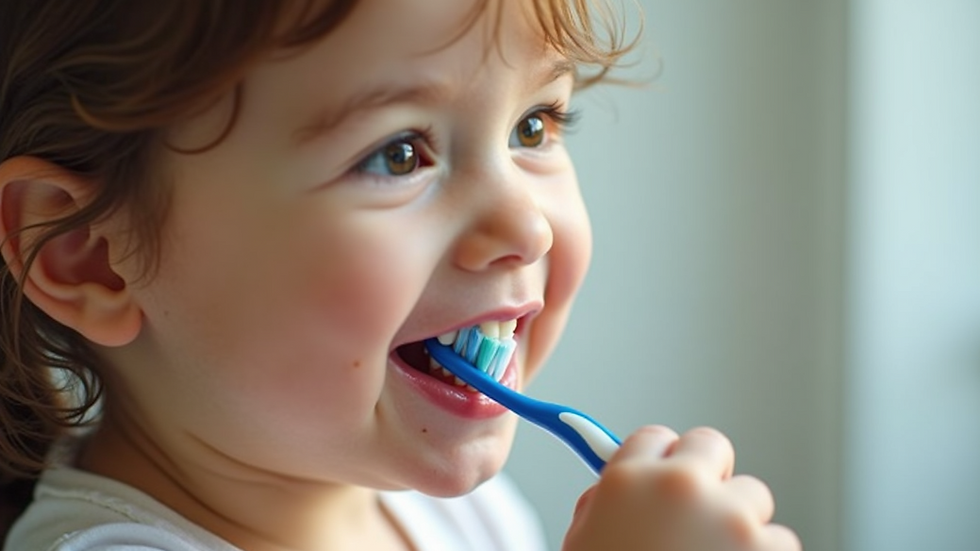How to Keep Your Child's Smile Bright and Healthy
- benbyronbill
- Sep 22
- 4 min read
A bright and healthy smile is one of the best gifts you can give your child. It not only boosts their confidence but also sets the foundation for good oral health throughout their life. Taking care of your child's teeth from an early age is essential to prevent cavities, gum disease, and other dental problems. This guide will walk you through practical steps and expert advice to keep your child's smile shining.
Tips for Maintaining Your Child's Smile
Maintaining your child's smile involves daily habits and regular dental care. Here are some simple yet effective tips:
Brush Twice a Day: Use a soft-bristled toothbrush and fluoride toothpaste. Help your child brush for at least two minutes, covering all surfaces of the teeth.
Floss Daily: Once your child has two teeth that touch, start flossing to remove food particles and plaque between teeth.
Limit Sugary Snacks and Drinks: Sugary foods and beverages can cause tooth decay. Encourage healthy snacks like fruits, vegetables, and cheese.
Encourage Drinking Water: Water helps wash away food particles and keeps the mouth hydrated.
Use Mouthguards for Sports: If your child plays contact sports, a mouthguard can protect their teeth from injury.
By establishing these habits early, you help your child develop a routine that supports long-term dental health.

Understanding the Importance of Your Child's Smile
Your child's smile is more than just an expression of happiness. It reflects their overall health and well-being. Healthy teeth and gums allow children to eat properly, speak clearly, and feel confident in social situations. Poor oral health can lead to pain, infections, and difficulties in school or play.
Regular dental check-ups are crucial to monitor your child's oral development and catch any issues early. Pediatric dentists specialize in caring for children's teeth and can provide tailored advice and treatments.
Incorporating a balanced diet rich in calcium, vitamin D, and other nutrients supports strong teeth and bones. Avoiding habits like thumb sucking or prolonged use of pacifiers can also prevent misalignment of teeth.

What is the difference between a pediatric dentist and a regular dentist?
Many parents wonder why they should take their child to a pediatric dentist instead of a regular dentist. The difference lies in the specialized training and approach.
Specialized Training: Pediatric dentists complete additional years of education focused on children's dental care, including growth and development, behavior management, and child psychology.
Child-Friendly Environment: Pediatric dental clinics are designed to be welcoming and less intimidating for children, with colorful decor and toys.
Tailored Treatments: Pediatric dentists use techniques and tools suited for smaller mouths and developing teeth. They also focus on preventive care and early intervention.
Behavior Management: They are skilled in managing children's anxiety and fear, making dental visits more comfortable.
Choosing a pediatric dentist ensures your child receives expert care that addresses their unique needs.
How to Prepare Your Child for Dental Visits
Dental visits can be stressful for children if they are not prepared. Here are some ways to make the experience positive:
Start Early: Schedule the first dental visit by your child's first birthday or when the first tooth appears.
Talk Positively: Use simple language to explain what will happen during the visit. Avoid using scary words like "pain" or "shot."
Read Books or Watch Videos: There are many child-friendly resources that explain dental visits in a fun way.
Bring Comfort Items: A favorite toy or blanket can help your child feel secure.
Stay Calm: Children pick up on parents' emotions. Stay relaxed and confident.
Regular visits to the dentist help your child become familiar with the environment and reduce fear over time.
Encouraging Good Oral Hygiene Habits at Home
Building good oral hygiene habits at home is key to a bright smile. Here are some strategies:
Make Brushing Fun: Use songs, timers, or apps to make brushing enjoyable.
Lead by Example: Brush your teeth together to show your child how it’s done.
Reward System: Use stickers or small rewards to motivate consistent brushing and flossing.
Teach Proper Technique: Show your child how to brush gently in circular motions and how to floss carefully.
Monitor and Assist: Children under 8 usually need help to brush effectively.
Consistency and encouragement will help your child develop lifelong habits that protect their smile.
When to Seek Professional Pediatric Dental Services
If you notice any signs of dental problems such as tooth pain, sensitivity, discoloration, or bleeding gums, it is important to seek professional care promptly. Early treatment can prevent more serious issues.
For comprehensive care, consider pediatric dental services that offer preventive, diagnostic, and restorative treatments tailored for children. These services include:
Routine cleanings and exams
Fluoride treatments and sealants
Cavity fillings and tooth extractions
Orthodontic evaluations
Emergency dental care
Regular visits to a pediatric dentist ensure your child's smile stays bright and healthy.
Supporting Your Child’s Smile for Life
A healthy smile is a lifelong asset. By teaching your child good oral hygiene, providing a nutritious diet, and ensuring regular dental visits, you set them up for success. Remember, prevention is always better than cure.
Encourage your child to take pride in their smile and understand the importance of dental care. Celebrate milestones like losing baby teeth and getting braces with positive reinforcement.
With your support and the expertise of pediatric dental professionals, your child’s smile will remain bright and healthy for years to come.





Comments